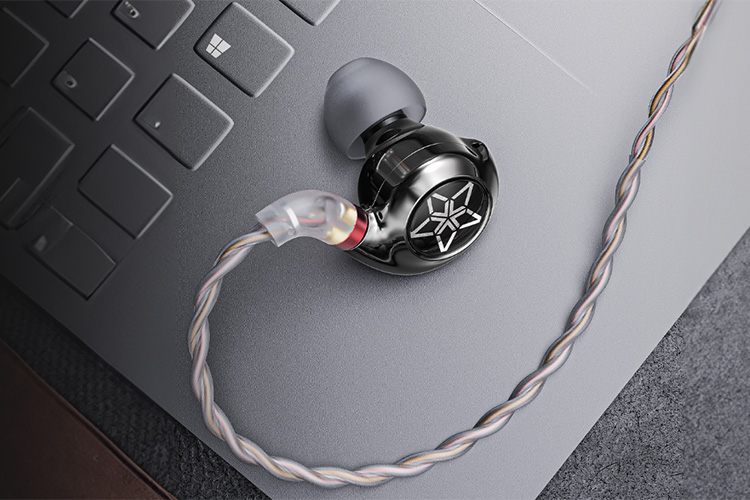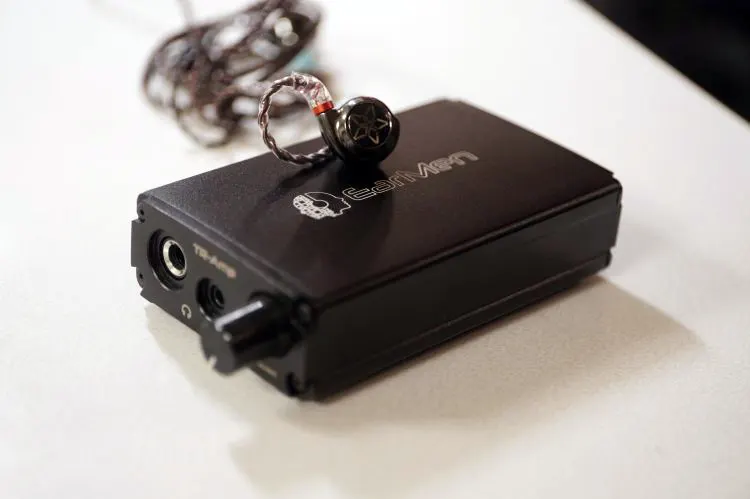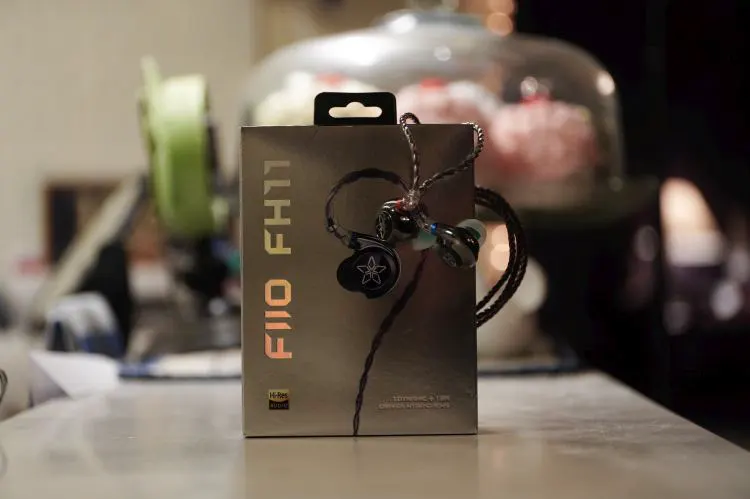Sound Impressions
Bass
The quantity on a flat EQ is relatively neutral for my tastes with the silicone tips and thicker with the foam tips.
With the silicone tips the IEM is sharp and quick on the draw, which means that there is no slow roll-off or mellow tonality anywhere from top to bottom. It is lightning fast, pure feeling in texture. The low end through the top side feels the same in terms of that crystalline sound.
EQ is almost needed to make this IEM feel more interesting and fuller-bodied if you intend to stick with silicone tips. The problem is that an effective bass booster will cause the IEM to lose its purity too much. This IEM is a finicky one.
Adding a +5dB adds more bass into the mix than any single other product I’ve ever reviewed. And just to be sure of that, I cycled through dozens of products for fun over an hour or two, all connected to the same portable xDuoo XD05 Plus that has a bass switch on it.
The FH11 goes from a neutral punchy bass quantity without the switch on, to a full-bodied bass monster IEM with the flip of a switch. The gains are huge for bass quantity potential added with just a small bass dB EQ adjustment. I’ve never seen anything like it before and never experienced such a drastic increase at this level.
Fidelity is excellent, as mentioned, the tone and texture are both very pure. However, with that bass booster active, the IEM churns itself into a muddied and hyper-thick experience. And this bleeds heavily into the mids. But this can be a blessing.
Mids
The bass bleeds into the mids, and any low-end EQ when activated, effectively makes this headphone unrecognizable from its stock form.
I like this IEM a lot more with bass active than without it unless the tips. Once more, the bleed into the mids from the low-end thickness increases making the entire IEM switch to a thicker, weightier, softer, and rounded experience.
With nothing active, the experience in the mids is slick, pure-feeling, sharper, and fast. But when the bass is added in, the experience of that brighter and more potent sheen vanished, almost entirely.
And this IEM became a little bit of a fun, bassy headphone with a thick midrange. It does cause the mids to sound more recessed than usual, but the stock form with no EQ active is still relatively middle-ground in placement, meaning not very forward and in your face, and not very recessive.
The purity with no EQ activated is highly satisfying. I can safely say that this budget IEM has one of the cleanest sounds in an IEM that I’ve played with in this price tier in a very long time.
Swapping between it and the recent FiiO FD11 that I have reviewed here, I believe this newer FH11 is audibly superior in quality across the board, and certainly in responsiveness (especially with bass).
Treble
Bright. Punchy. Slamming. A little sharp. But enjoyably and not overly powerful. This is a very engaging set of IEMs; physical slam is on the high end of moderate in quantity.
That means it hits fairly hard and snaps a good amount. Mellow and soft, or elegant, are not terms and statements I would use to describe it. Engaging, bright, interesting, lively, and highly energized; these are terms that I would use instead.
I am a big fan of Falling in Reverse; if you know, you know. The track “I’m not a Vampire” has some elegant piano key taps, orchestral backgrounds, cello work, and a bit of high-pitched shrieking and death metal screaming.
The FH11’s treble is ideal for this. This almost feels like some big event that I am listening to, an epic journey of discovery, or something profound on that level. A lower-end IEM playing music like this so well and finding its real center is rare.
The lead vocalist is quite stellar in this band (Ronnie) and his voice range is impressive, to say the least. But, the FH11 has this knack for an excessive response that will go from overly plentiful treble, to smoother and tonally refined, and then engage the listener with tactile treble response slam-effect, and then instantly drop back down to pleasant.
So yes, the FH11 is easily the best response range in a budget IEM I’ve ever reviewed. Just as the bass can invert itself from thinner and lacking, to impressively thick and weighted with a good EQ system, the treble does the same. This entire excellent tone response change is worth the price alone.
Imaging
The FH11 is fairly bright and prominent on the airiness of the top end. This makes the product sound more spacious and open than it actually is. What there is, is still pretty good overall.
The height and coherency of the spectrum as a whole (its shape) are always on point with FiiO IEMs, so this is not a shock to me that the experience is well-rounded in depth, height, and width. But the void bubble itself is fairly large for a budget IEM.
Depth of field and width are just good, but the height and physical stature, and realism of voices and instruments ended up in what I would classify as very good. This plays extremely well with studio recordings of Jazz and prominent vocalist tracks in general.
From Metal to Jazz standards, it doesn’t really matter. Anything vocalist centered tends to sound commanding and large-field in terms of height.
Select Comparisons
FiiO FD11
At the same price, the FD11 has a less stable fit, as the shells are slippery and smooth. Also, the FD11 is far less capable of responding to different tone types in your gear.
The FH11 can grab significantly more bass quantity. The FD11 is more clinical in tone, and the stock sound of the FH11 is more neutral and can swing drastically to warm in an instant.
FiiO JD7
This FH11 is audibly superior in fidelity across the board and significantly better in overall response to alteration and tone changes, depending on your amp or source.
The FiiO JD7 is smaller, and I receive a better fit with the snug shape of the FH11. Bass potential on the JD7 is far less, the FH11 can dig very deep in comparison, but only when amped and with a boost switch active.
FiiO FH1s
Let’s jump back to April of 2020 when I first reviewed the FiiO FH1s which is now the same price as the FH11. If you ask me, FiiO was highly inspired by the older FH1s, as both retain a high sense of bass potential and a static neutral colorless tone when not amped and not using a warm source.
It is a hard call to make, but I think the new FH11 is a slight improvement over the FH1s in fidelity across the board. However, the FH1s does not change anywhere near as much when a lot of power is introduced, and more bass is added via EQ.
The stock FH1s experience and the amped+ boosted experience are generally not that far off. However, as mentioned, the FH11 goes from stark neutral and lacking bass to a lot of bass suddenly and a warmer, softer tone. These IEMs sound very similar but I prefer the FH1s tone a bit more.
Our Verdict
FiiO has clearly invaded the old FH1’s lair and taken its best qualities, revised it, and then tossed new shells over what they learned.
As much as I love the look of the older FH1, I find it to not fit as nicely as the new FH11. There is something about the older model though, a slight sheen perhaps on the treble that I enjoy more.
But the FH11 and FH1 are blood brothers and derivatives of each other, unquestionably. And both are lovely, but if you want the new cool hotness, then the FH11 is the way to go, clearly
FiiO FH11 Technical Specifications
- Driver: 10mm Carbon-based dynamic driver, custom balanced armature driver
- Frequency response: 20Hz-20kHz
- Impedance: 24 ohms @ 1kHz
- Sensitivity: 111dB/mW @ 1kHz
- Cable: 4 strands of 120 oxygen-free copper wires each
- Cable length: about 1.2m
- Single unit weight: about 10g
- Headphone connector: recessed 0.78mm 2-pin detachable cable
- Audio connector: high-quality 3.5mm gold-plated copper







